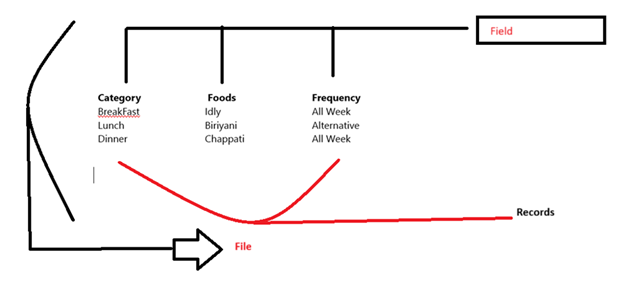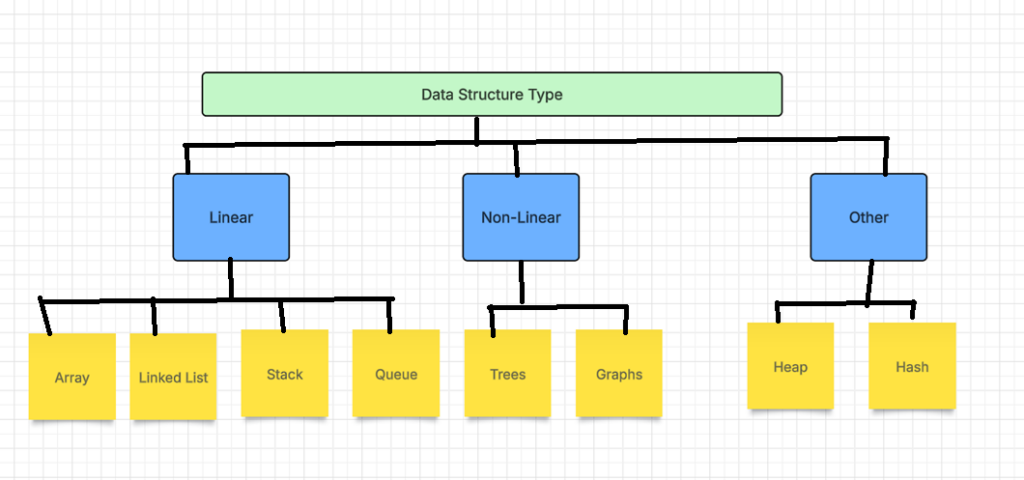Introduction / அறிமுகம்
Data Structures / தரவுகளின் அமைப்பு
Definition
Data structures are used to store and organize data on certain pattern so that it can be accessible when need in a efficient way
பொருள்
தரவுகளை (Data) செயல்படுத்தவும், சேமிக்கவும், ஒழுங்குபடுத்தவும் பயன்படுத்தப்படும் ஒரு முறை.
Data:
It nothing but a value or set of values. Otherwise it is a raw inputs to computer for processing.
In data structure, collection of data is frequently organized in particular order as fields, records, and files.
Field: Unit of information representing an attribute of an entity.
Records: Collection of field values
File: Collection of records on a given set.
தரவு
இது ஒரு மதிப்பு அல்லது மதிப்புகளின் தொகுப்பைத் தவிர வேறில்லை. இல்லையெனில் அது கணினியில் செயலாக்கத்திற்கான மூல உள்ளீடுகளாகும்.
தரவு கட்டமைப்பில், தரவு சேகரிப்பு பெரும்பாலும் புலங்கள், பதிவுகள் மற்றும் கோப்புகள் என குறிப்பிட்ட வரிசையில் ஒழுங்கமைக்கப்படுகிறது.
புலம் – ஒரு பொருளைப் பற்றிய தகவல்களை வழங்குதல் (Field)
பதிவுகள் -புல மதிப்புகளின் தொகுப்பு – (Records)
பட்டியல் – கொடுக்கப்பட்ட தொகுப்பில் பதிவுகளின் சேகரிப்பு (File)

Data Structure Importance
Helps to organize the data’s in the computer, resulting in more efficient programs
Data is organized efficiently, so program can executes faster and on less memory resource usage and is scalable.
With high computational and processing to solve more and more complex problems
தரவு அமைப்பின் முக்கியத்துவம்
கணினியில் உள்ள தரவுகளை ஒழுங்கமைக்க உதவுகிறது, இதன் விளைவாக மிகவும் திறமையான நிரல்கள் உருவாகின்றன.
தரவு திறமையாக ஒழுங்கமைக்கப்படுகிறது, இதனால் நிரல் வேகமாகவும் குறைந்த நினைவக வள பயன்பாட்டிலும் இயங்க முடியும் மற்றும் அளவிடக்கூடியது.
அதிக கணக்கீட்டு மற்றும் செயலாக்கத்துடன் மேலும் மேலும் சிக்கலான சிக்கல்களைத் தீர்க்க முடியும்.
Why Data Structure?
Efficient data handling: They provide specific formats for organizing data, which allows for faster and more efficient access and manipulation.
Improved performance: By choosing the right structure for a task, operations like searching, sorting, and deleting become significantly quicker, leading to faster execution times and better use of system resources.
Simpler and more maintainable code: Data structures can simplify algorithms, making the logic easier to understand, modify, and debug.
Real-world modeling: They are used to model complex relationships, such as using trees to represent a file system or graphs to represent social networks.
Reusability: They allow data to be stored in reusable formats that can be accessed and utilized in various parts of a program or by different programs.
தரவு கட்டமைப்பு ஏன்?
திறமையான தரவு கையாளுதல்: தரவை ஒழுங்கமைப்பதற்கான குறிப்பிட்ட வடிவங்களை அவை வழங்குகின்றன, இது வேகமான மற்றும் திறமையான அணுகல் மற்றும் கையாளுதலை அனுமதிக்கிறது.
மேம்பட்ட செயல்திறன்: ஒரு பணிக்கான சரியான கட்டமைப்பைத் தேர்ந்தெடுப்பதன் மூலம், தேடுதல், வரிசைப்படுத்துதல் மற்றும் நீக்குதல் போன்ற செயல்பாடுகள் கணிசமாக விரைவாகின்றன, இது விரைவான செயல்படுத்தல் நேரங்களுக்கும் கணினி வளங்களை சிறப்பாகப் பயன்படுத்துவதற்கும் வழிவகுக்கிறது.
எளிமையான மற்றும் பராமரிக்கக்கூடிய குறியீடு: தரவு கட்டமைப்புகள் வழிமுறைகளை எளிதாக்கலாம், தர்க்கத்தைப் புரிந்துகொள்வது, மாற்றுவது மற்றும் பிழைத்திருத்தத்தை எளிதாக்குகிறது.
நிஜ உலக மாதிரியாக்கம்: கோப்பு முறைமையைக் குறிக்க மரங்களைப் பயன்படுத்துவது அல்லது சமூக வலைப்பின்னல்களைக் குறிக்க வரைபடங்களைப் பயன்படுத்துவது போன்ற சிக்கலான உறவுகளை மாதிரியாக்க அவை பயன்படுத்தப்படுகின்றன.
மறுபயன்பாடு: ஒரு நிரலின் பல்வேறு பகுதிகளில் அல்லது வெவ்வேறு நிரல்களால் அணுகக்கூடிய மற்றும் பயன்படுத்தக்கூடிய மீண்டும் பயன்படுத்தக்கூடிய வடிவங்களில் தரவைச் சேமிக்க அவை அனுமதிக்கின்றன.
Data Structure Types:
Linear Data Structure: A Data structure is linear if every item is related to its previous and next item (Example : Array , Linked List, Stack, Queues)
Non Linear Data Structure : A Data structure is non-linear if every item is attached to many other items in specific pattern to reflect relationships (Example: Trees, Graphs)
Other: A Data structure is Binary tree (Example: Heap, Hash)
தரவு அமைப்பு வகைகள்:
நேரியல் தரவு அமைப்பு: ஒவ்வொரு உருப்படியும் அதன் முந்தைய மற்றும் அடுத்த உருப்படியுடன் தொடர்புடையதாக இருந்தால் ஒரு தரவு அமைப்பு நேரியல் ஆகும் (எடுத்துக்காட்டு: வரிசை, இணைக்கப்பட்ட பட்டியல், அடுக்கு, வரிசைகள்)
நேரியல் அல்லாத தரவு அமைப்பு: ஒவ்வொரு உருப்படியும் உறவுகளை பிரதிபலிக்கும் வகையில் குறிப்பிட்ட வடிவத்தில் பல உருப்படிகளுடன் இணைக்கப்பட்டிருந்தால் ஒரு தரவு அமைப்பு நேரியல் அல்லாதது (எடுத்துக்காட்டு: மரங்கள், வரைபடங்கள்)
மற்றவை: ஒரு தரவு அமைப்பு பைனரி மரம் (எடுத்துக்காட்டு: குவியல், ஹாஷ்)
